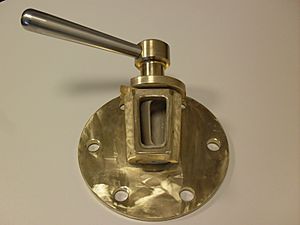Sample (material) facts for kids
A sample is a small part of something bigger. It's like taking a tiny piece of a cake to know what the whole cake tastes like. This small piece is meant to show you what the larger amount is like.
Samples can be things you can count, like individual cookies from a big batch. Or they can be materials you can't easily count, like a spoonful of sugar from a bag. Even a whole plant or rock can be called a sample if it's taken for study.
The process of getting a sample is called "sampling." People can do it by hand, or machines can do it automatically. Samples are often taken for testing, checking quality, or showing what something is like. Sometimes, sampling happens all the time, like in a factory.

Contents
Why Do We Take Samples?
We take samples for many important reasons. They help us learn about a larger group or amount without having to check every single piece.
- Testing: Imagine a scientist needs to know if a lake's water is clean. They don't test all the water. They take a small water sample to test in a lab.
- Analysis: Doctors take a small blood sample to analyze your health. This helps them understand what's happening inside your body.
- Quality Control: Factories take samples of products to make sure they are made correctly. For example, a cookie factory might taste a few cookies from each batch.
- Demonstration: When you try a small piece of cheese at a grocery store, that's a sample. It shows you what the full product is like.
Different Kinds of Samples
Samples can come in many forms. What a sample looks like depends on what it is made of.
Liquid Samples: Aliquots
When scientists take a liquid sample, it's sometimes called an aliquot. This is a special word for a sample that is an exact part of the whole. For example, if you have 100 milliliters (mL) of a liquid, 10 mL would be an aliquot. It means 10 mL divides evenly into 100 mL (100 divided by 10 is 10).
Solid, Gas, and Other Samples
Samples can be solid, like a piece of rock or a food item. They can be liquid, like water or juice. They can also be gas, like air. Sometimes, samples are soft and gooey, like a gel. Even tiny pieces of living things, like plant tissue, can be samples.
The amount of a sample can be described by its size, weight, or how much space it takes up (volume). A solid sample might be one piece, or it could be tiny grains or powder. A piece of wire or a section of a tube can also be a sample. Most samples that aren't solid pieces are kept in special containers.
See also
- Core sample
- Ice core
- Specimen (disambiguation)


